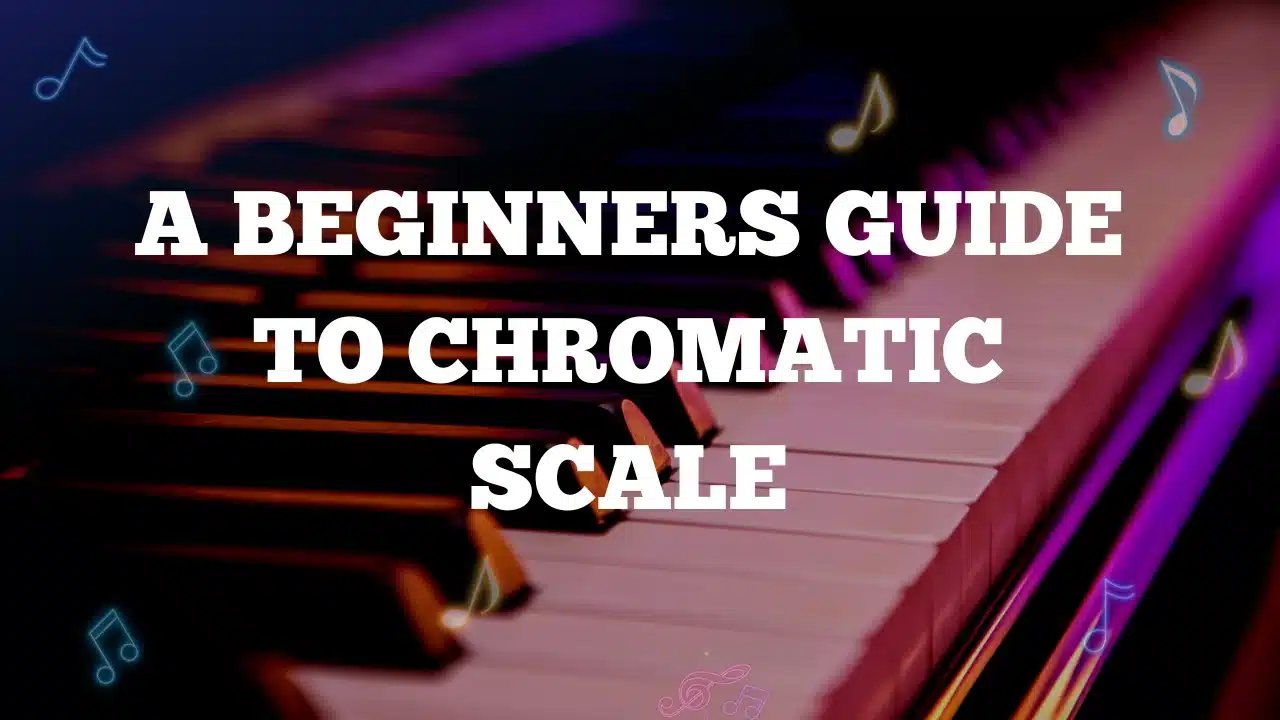Did you know? A chromatic note does not belong to any scale! Well, a Chromatic Scale on piano doesn’t have a starting point or a resting note ie, no clear tonal center. There is no emphasis on any particular note being an important one.
What is a Chromatic Scale?
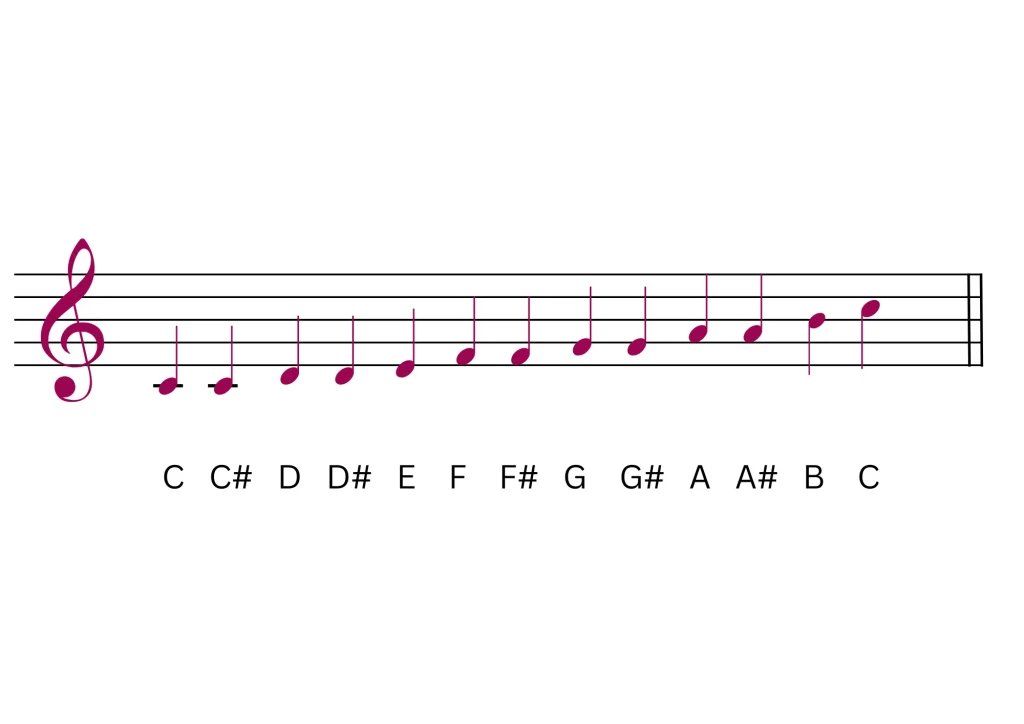
It is musical scale containing all the twelve pitches in an octave. These pitches are separated by a half step only. You know this is an easy concept crack and is also one of the most fundamental scales in Western Music. More complex scales and harmony begin from Chromatic Scales. Let’s take a step back and look into what a Half Step is.

Did You Know?
The word ‘Chromatic’ originates from a Greek word ‘Chroma’ meaning color.
What is a Chromatic Half Step?

Look at this piano. The distance between a white key and a black key is a half step. This is called Semitone. For instance C to C# is a half step. This is the smallest interval in western music.
What is a Whole Step?

Simply put, two half steps equal a whole step. Whole step is also called tone in music. For instance C to D is a whole step.
So the take away point is that,
- The chromatic scale notes move exclusively in half steps with all the 12 pitches within an octave.
- Learning to play chromatic scale piano can help you grasp the concept better.
- Learning to play chromatic scale guitar can help you understand how the notes move within the scale.
How to Write a Chromatic Scale?
You can actually write the chromatic scale notes from any note. All you need to remember is that the sequence consists of all the pitches. Here is an instance of a chromatic scale piano. Visualize a piano,
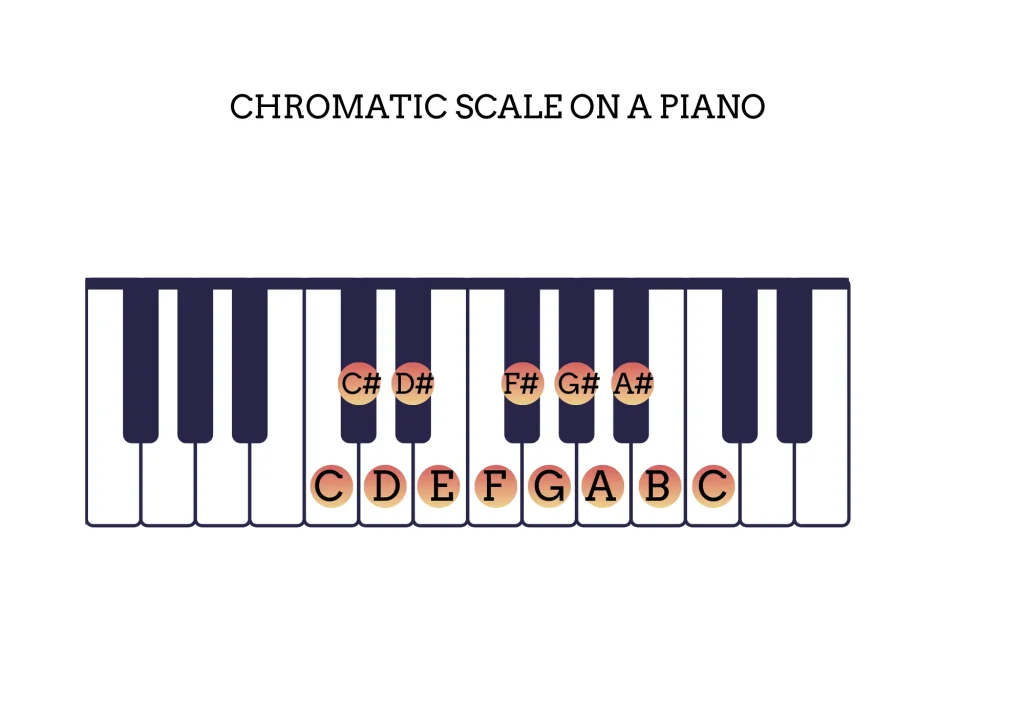
So a chromatic scale piano will have,
From the Key C, all the white keys: C D E F G A B C
And all the black keys: C# D# G# A# B# C#
Ascending: C, C#, D, D#, E, F, F#, G, G#, A, A#, B, C.
Descending: C, B, A#, A, G#, G, F#, F, E, D#, D, C#, C.

Hot tip!.
The keys repeat every 12 notes and form a pattern of octaves.
Chromatic Scale Guitar
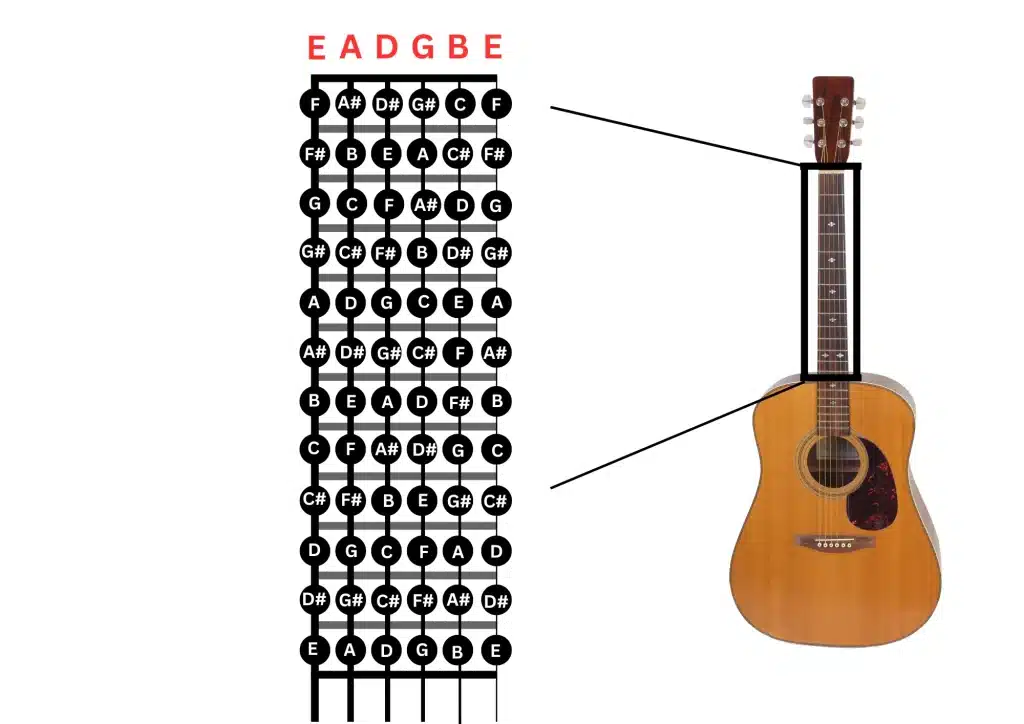
We know that each fret represents a half step on a guitar. So a chromatic scale guitar involves moving up and down the frets.
Let’s start playing on a single guitar string.
For Instance, begin playing from the 5th fret of the low E string.
5th fret A
6th fret A#
7th fret B
8th fret C
9th fret C#
10th fret D
11th fret D#
12th fret E
13th fret F
14th fret F#
15th fret G
16th fret G#
You can keep moving to the next string (A) on the 5th fret(D) for the next pattern. Continue the same pattern in the same method across all guitar strings! So this is Chromatic scale guitar for you!

Hot tip!
You can try practicing the chromatic scales starting from different frets and positions to become familiar with the entire fretboard of a guitar.
Enharmonics
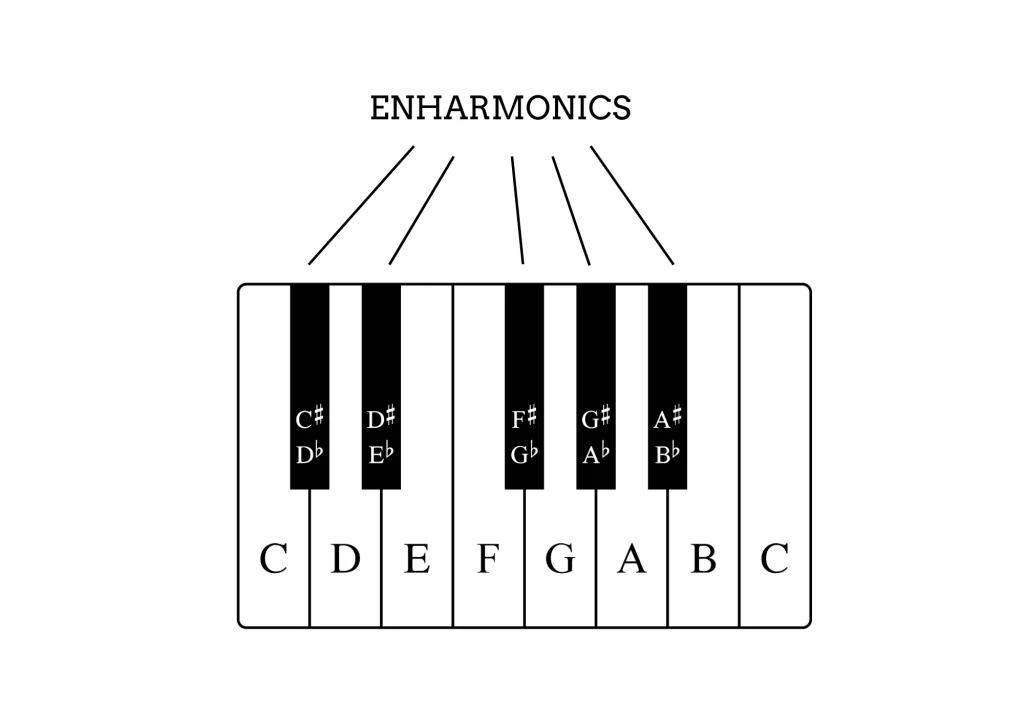
Some chromatic scale notes have different names but same pitches. For example, C# can also be called as Db. Such notes are called enharmonics. And so in a chromatic scale, these notes represent the same pitches but are used in different musical contexts.
How to Write a Chromatic Scale?
Follow these 5 easy steps to write a chromatin scale.
Step 1: Determine the key. If you want to start the scale from D, the note D will be your starting point.
Step 2: Start writing the notes moving by half a step. So if your starting note is D, the next note would be D# and then E and so on.
For example, A chromatic scale notes starting from D,
Ascending: D, D#, E, F, F#, G, G#, A, A#, B, C, C#, D.
Descending: D, C#, C, B, A#, A, G#, G, F#, F, E, D#, D.
Step 3: Consider enharmonics equivalents and write the scale accordingly.
Step 4: Add all the accidentals needed to complete the scale unless you use a key signature.
Step 5: Check if all the 12 pitches are used in your scale.
Uses and Importance of Chromatic scales
- Mastering chromatic scale fingering helps in developing proficiency in Piano. Improvement in finger agility and coordination is achieved by practicing chromatic scale notes. Therefore, complex pieces involving rapid note change become easier with chromatic scale piano.
- Not just playing, singing and practicing these scales helps in achieving even tone and consistent rhythm. Ergo, smooth performances are right up your sleeve!
- Here’s the thing, I use a lot of chromatic patterns as ornamentation when I sing. These types of scales can be used to add color to the melodies you sing or play. Ton of chromatic scale exercises are available online.
- Have you heard of Chromaticism? It’s an interesting technique used to smoothly transfer between different keys. In simple words, using notes that are not in the major or scale in which a piece of music is written is called Chromaticism. This technique would add a sense of complexity to the piece of music.
- Understanding chromatic scale theory helps in exploring the full range of pitches and creating rich harmonies. Concepts like Augmented or Diminished chords are based on chromatic scale notes.
- Lastly, yet notably chromatic scales in music happen to be the foundation for other whole noted scales and different modes.

Hot Tip!
Chromatic passing tones can make a melody more expressive.
Chromatic Vs Diatonic Scale
Both Chromatic and Diatonic scales are fundamental concepts in Western music. However, each has different functions in composing music.
A chromatic scale has 12 pitches in an octave while a diatonic scale has 7 distinctive pitches in an octave. The 12 pitches in chromatic scale notes have an interval of half step or semitone. The 7 pitches in a diatonic scale follow a specific pattern of whole steps and half steps.
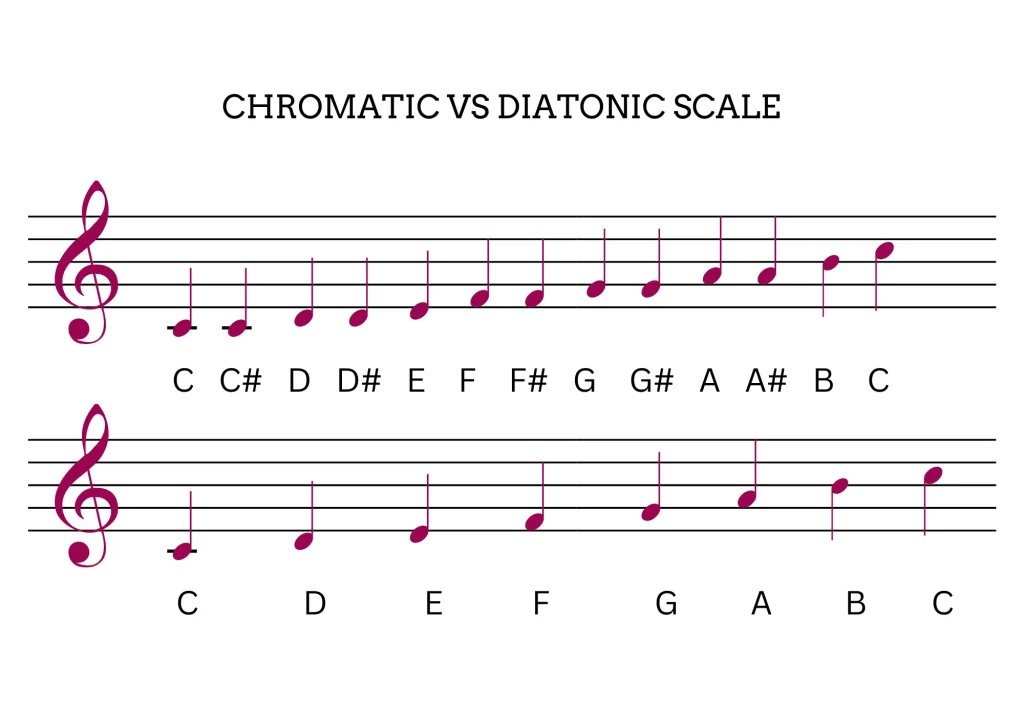
Chromatic scales are used to create tension or express a sense of dissonance and doesn’t suggest a particular key lacking tonal center. It is commonly used in contemporary genres involving complex harmonic structures. On the other hand, the diatonic scale provides a structured framework for melody and harmony. Diatonic scales most used in classical compositions.
Closing Thoughts
This guide for understanding chromatic scale for beginners gives you a broad idea of the concept along with its applications and importance. A solid tip to master the concept is through recognising chromatic scale piano. To learn more musical concepts, book a Free Demo with us!
FAQs
What is a chromatic scale in music?
It is a sequence of 12 pitches in an octave with an interval of half step between each note.
How to play the chromatic scale on the piano?
For instance, chromatic scale piano begins with C and keeps moving half step until you reach the C note of the next octave.
What is the difference between a chromatic and diatonic scale?
Chromatic scale has 12 pitches whereas a diatonic scale has 7 pitches.
What are the notes in the chromatic scale?
C, C#, D, D#, E, F, F#, G, G#, A, A#, B, C.
C, B, A#, A, G#, G, F#, F, E, D#, D, C#, C.
How to practice the chromatic scale on guitar?
Each fret represents a half step on a guitar. So a chromatic scale guitar involves moving up and down the frets.
Why is the chromatic scale important in music?
It provides complex harmonic structures to melodies.
Related blog: Modes of scale in music

